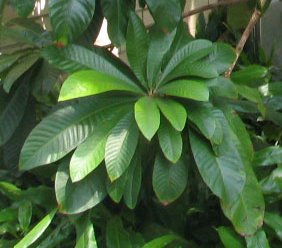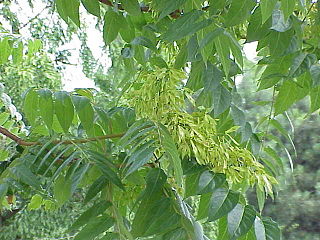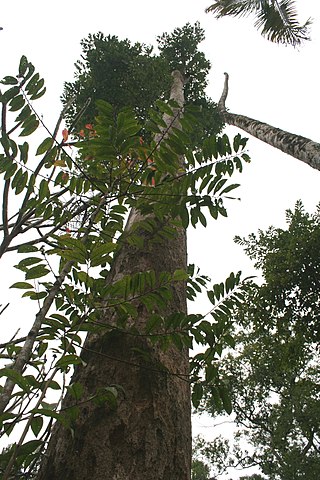
The Sapotaceae are a family of flowering plants belonging to the order Ericales. The family includes about 800 species of evergreen trees and shrubs in around 65 genera. Their distribution is pantropical.

Chrysophyllum is a group of trees in the Sapotaceae described as a genus by Linnaeus in 1753.

Palaquium is a genus of about 120 species of trees in the family Sapotaceae. Their range is from India across Southeast Asia, Malesia, Papuasia, and Australasia, to the western Pacific Islands.

Manilkara is a genus of trees in the family Sapotaceae. They are widespread in tropical and semitropical locations, in Africa, Madagascar, Asia, Australia, and Latin America, as well as various islands in the Pacific and in the Caribbean. A close relative is the genus Pouteria.

Manilkara zapota, commonly known as sapodilla, sapote, naseberry, nispero or chicle, is a long-lived, evergreen tree native to southern Mexico, Central America and the Caribbean. An example natural occurrence is in coastal Yucatán in the Petenes mangroves ecoregion, where it is a subdominant plant species. It was introduced to the Philippines during Spanish colonization. It is grown in large quantities in Mexico and in tropical Asia including India, Pakistan, Thailand, Malaysia, Cambodia, Indonesia, Vietnam, Bangladesh.

The Simaroubaceae are a small, mostly tropical, family in the order Sapindales. In recent decades, it has been subject to much taxonomic debate, with several small families being split off. A molecular phylogeny of the family was published in 2007, greatly clarifying relationships within the family. Together with chemical characteristics such as the occurrence of petroselinic acid in Picrasma, in contrast to other members of the family such as Ailanthus, this indicates the existence of a subgroup in the family with Picrasma, Holacantha, and Castela.

Pouteria is a genus of flowering trees in the gutta-percha family, Sapotaceae. The genus is widespread throughout the tropical regions of the world. It includes the canistel, the mamey sapote, and the lucuma. Commonly, this genus is known as pouteria trees, or in some cases, eggfruits.

Sideroxylon is a genus of trees in the family Sapotaceae described as a genus by Linnaeus in 1753. They are collectively known as bully trees. The generic name is derived from the Greek words σιδηρος (sideros), meaning "iron", and ξύλον (xylon), meaning "wood."

Anisophyllea is a genus of plant in the family Anisophylleaceae. The generic name is from the Greek meaning "unequal leaf", referring to the dimorphism of the leaves.

Esenbeckia is a genus of flowering plants in the rue family, Rutaceae. All species in the genus are native to the Americas, with the highest diversity in South America. They are commonly known as jopoy, the Mayan word for E. berlandieri, or gasparillo (Spanish).

Madhuca is a genus of plants in the family Sapotaceae first described as a genus in 1791.

Vitellariopsis is a group of plants in the family Sapotaceae described as a genus in 1915. The genus is native to eastern and southern Africa.
- Vitellariopsis cuneata(Engl.) Aubrév. - Usambara Mts in Tanzania
- Vitellariopsis dispar(N.E.Br.) Aubrév. - Eswatini, KwaZulu-Natal
- Vitellariopsis ferrugineaKupicha - Zimbabwe
- Vitellariopsis kirkii(Baker) Dubard - Nampula, Tanzania, Kenya
- Vitellariopsis marginata(N.E.Br.) Aubrév. - Mozambique, Eswatini, South Africa

Xylopia is a genus of flowering plants in the family Annonaceae. They are mostly trees and some shrubs. There are about 160 species distributed in Asia, Africa, and the Americas.

Chrysophylloideae is a subfamily of flowering plants in the chicle family, Sapotaceae.

Dodonaeoideae is a subfamily of flowering plants in the soapberry family, Sapindaceae.
Planchonella is a genus of flowering trees in the gutta-percha family, Sapotaceae. Named in honour of Jules Émile Planchon, it contains around 100 mainly tropical species, two of which occur in South America and about 18 in Australasia. It was described by Jean Baptiste Louis Pierre. The genus is included in the larger genus Pouteria by some authorities, hence species such as Planchonella queenslandica are also known as Pouteria queenslandica.

Labourdonnaisia is a genus of plants in the family Sapotaceae found in tropical Asia, described as a genus in 1841.
Pseudosmodingium is a genus of plants in the subfamily Anacardioideae of the cashew and sumac family Anacardiaceae.
Donella is a genus of flowering plants belonging to the family Sapotaceae.
















